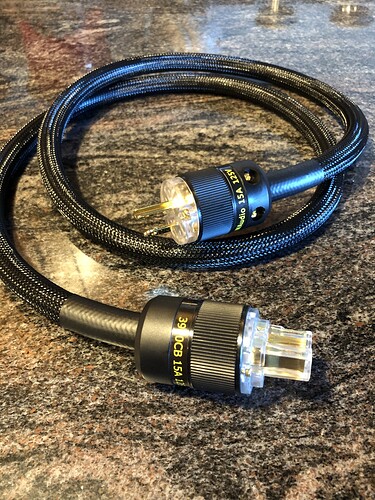It made absolutely no sense to me getting into it, and yours is the most common criticism/challenge that is hard to simply explain away. In the end, I don’t think anybody fully understands what’s going on, but I can share some explanations I’ve heard that are probably at least partial contributors to the whole pie. At the end of the day, though, hearing is believing, and if you ever get the chance to demo a really nice power cord, especially into your conditioner, it’s unlikely you’ll ever go back.
1) Gauge - Audiophile power cables tend to be heaver gauge than stock cables, and I think this one is the easiest to wrap your head around for difference making. Your components just get the juice they want and need more easily. What’s interesting is that many companies offer lower and higher (smaller / source) gauge variants of their cables, but I’ve read that many people get better results from the heaver gauge, even for components that don’t theoretically “need” it.
2) Connectors - Every connection in your chain is an opportunity for loss and distortion, and power is no exception. Audiophile power cables simply have better connectors with better conducting materials, built in a better way (ideally, at least). Take this Furutech male connector at a whopping $374, for example. As you go up in quality, you just get better materials with better construction, which mirrors many of the other components in your system. If the power cable connectors weren’t enough, I’ll throw another piece into the puzzle by noting that a better wall plug itself also helps, in part, by gripping the cable better, but also with better materials. That’s right folks - I heard a very real improvement from an upgraded audiophile outlet. “Ugh” is right…
3) Noise Rejection - Whether by shielding or by noise-rejecting winding patterns (neither or which are considered particularly controversial, AFAIK, at least in analog interconnects) or both, power cables can pick up noise and transfer that noise into your system. Keeping it out of the cable in the first place helps.
4) Noise Drainage - As I understand it, one can manipulate attributes of a cable (any cable) to better facilitate draining things like RF interference to ground. Think of it as a better functioning drain in a bathtub that’s trying to constantly fill up with distortion that could affect the sound.
At the end of the day, it seems that the affect of these individual parts is only moderately understood, but taken together, the difference is obvious if you just trust your ears.
One of my biggest criticisms of a big chunk of the audiophile community is actually having way too much hubris in terms of thinking they understand, or even thinking they need to understand the detailed mechanisms or reasons a given component could make a difference to accept that it does indeed make an audible difference. It’s touted as being “objective” or “scientific”, but it’s actually quite un-scientific (I’m looking at you, Audio Science Review). To be clear, I think it’s well intentioned, and I absolutely support the effort, but saying a power cord can’t make a difference because we haven’t found the right measurement or reason(s) is akin to our far-gone ancestors saying that aloe vera can’t possibly be a soothing plant because they haven’t established the molecular pathways by which it works yet. At the end of the day, if it’s obvious that there is a difference between a bad power cord and a good one - which almost anyone with a sensitive system and ears will tell you there is - then you don’t shut them down because your current measurements don’t show it (e.g. frequency response), but rather, you look for a better measurement. Put simply, “try to explain, conclude” is not scientific - “test, conclude, then try to explain” is.
